Salt varies greatly with quality, mineral content, and health benefits
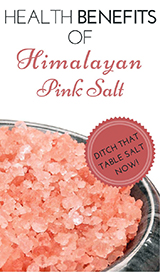 Refined Salt: White Poison - The problem with salt is not the
salt itself but the condition of the salt we eat! Our regular table salt no longer has anything in common with the original
crystal salt. Salt now a day is mainly sodium chloride and not salt.
Refined Salt: White Poison - The problem with salt is not the
salt itself but the condition of the salt we eat! Our regular table salt no longer has anything in common with the original
crystal salt. Salt now a day is mainly sodium chloride and not salt.
With the advent of industrial development, our natural salt was "chemically cleaned"
and reduced only to sodium and chloride. Major producing companies dry their
salt in huge kilns with temperatures reaching 1200 degrees F, changing he salt's
chemical structure, which in turn adversely affects the human body. The common
table salt we use for cooking has only 2 or 3 chemical elements. The seawater
has 84 chemical elements. For our body to be healthy we need all those elements.
When we use the common salt, we are in deficit of 81 elements which means we
are somehow contributing to becoming weaker, imbalanced and more susceptible
to diseases. Use the seawater salt.
Salt is vital to all living creatures
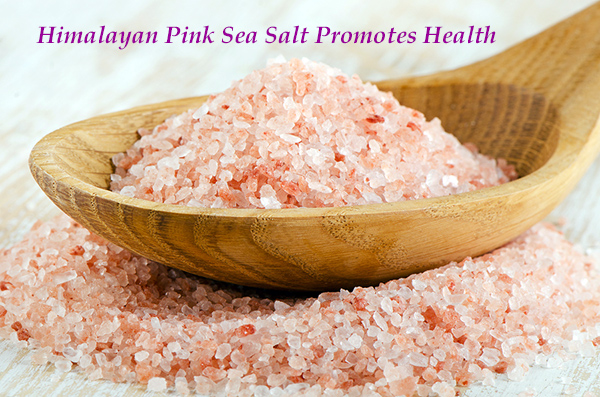 Salt is a vital substance for the survival of all living creatures, particularly
humans. Water and salt regulate the water content of the body. Water itself
regulates the water content of the interior of the cell by working its way into
all of the cells it reaches.
Salt is a vital substance for the survival of all living creatures, particularly
humans. Water and salt regulate the water content of the body. Water itself
regulates the water content of the interior of the cell by working its way into
all of the cells it reaches.
It has to get there to cleanse and extract the
toxic wastes of cell metabolisms. Salt forces some water to stay outside the
cells. It balances the amount of water that stays outside the cells.
There are two oceans of water in the body; one ocean is held inside the cells of the body,
and the other ocean is held outside the cells. Good health depends on a most
delicate balance between the volume of these oceans, and this balance is achieved
by salt - unrefined salt.
When water is available to get inside the cells freely, it is filtered from
the outside salty ocean and injected into the cells that are being overworked
despite their water shortage. This is the reason why in severe dehydration we
develop an edema and retain water. The design of our bodies is such that the
extent of the ocean of water outside the cells is expanded to have the extra
water available for filtration and emergency injection into vital cells. The
brain commands an increase in salt and water retention by the kidneys. This
is how we get an edema when we don't drink enough water.

Water and Salt is the Essence of Life
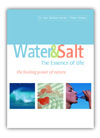 by Dr. Barbara Hendel and biophysicist Peter Ferreira.
by Dr. Barbara Hendel and biophysicist Peter Ferreira.
Never before has there been such a fascinating book about the fundamental
two essential elements needed for achieving and maintaining vibrant health.
From the first day that this book was introduced in Germany two years ago, it
was an immediate bestseller. Millions of people have changed their lives in
respect to water and salt with the profound scientific information presented
herein in an easy-to-read format that everyone is able to understand. We are
happy to now make our English speaking readers acquainted with the subjects
of Water and Salt so that they too may find better understanding and respect
for these most essential elements. We also hope that thousands of doctors, scientists,
alternative practitioners and therapists will embrace this natural knowledge
to help mankind in a natural way.
Initially, the process of water filtration and its delivery into the cells
is more efficient at night when the body is horizontal. The collected water,
that mostly pools in the legs, does not have to fight the force of gravity to
get onto the blood circulation. If reliance of this process of emergency hydration
of some cells continues for long, the lungs begin to get waterlogged at night,
and breathing becomes difficult. The person needs more pillows to sit upright
to sleep. This condition is the consequence of dehydration. However, you might
overload the system by drinking too much water at the beginning. Increases in
water intake must be slow and spread out until urine production begins to increase
at the same rate that you drink water.
When we drink enough water to pass clear urine, we also pass out a lot of
the salt that was held back. This is how we can get rid of edema fluid in the
body; by drinking more water. Not diuretics, but more water!! In people who
have an extensive edema and show signs of their heart beginning to have irregular
or very rapid beats with least effort, the increase in water intake should be
gradual and spaced out, but not withheld from the body. Naturally, salt intake
should be limited for two or three days because the body is still in an overdrive
mode to retain it. Once the edema has cleared up, salt should not be withheld from the body.
Paracelsus institutes fresh medical concept
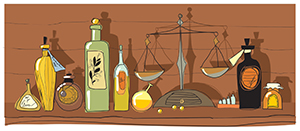 The doctor and alchemist Paracelsus (1493–1541 A.D.) introduced an entirely
new medical concept. He believed that external factors create disease and conceived
a chemically oriented medical system which contrasted with the prevalent herbal
medicine. Only salted food could be digested properly: "The human being must
have salt, he cannot be without salt. Where there is no salt, nothing will remain,
but everything will tend to rot."
The doctor and alchemist Paracelsus (1493–1541 A.D.) introduced an entirely
new medical concept. He believed that external factors create disease and conceived
a chemically oriented medical system which contrasted with the prevalent herbal
medicine. Only salted food could be digested properly: "The human being must
have salt, he cannot be without salt. Where there is no salt, nothing will remain,
but everything will tend to rot."
He recommended salt water for the treatment
of wounds and for use against intestinal worms. A hip-bath in salt water was
a superb remedy for skin diseases and itching: "This brine - he said - is better
than all the health spas arising out of nature." He described the diuretic effect
of salt consumption and prescribed salt preparations of different strengths
that were used for instance against constipation. Salt-based remedies were thought
to have expectorant powers. A mixture of water, salt, and vinegar was employed
as an emetic. Drinking a mixture of two-thirds cow's milk and one-third salt-water,
in the mornings, on an empty stomach was recommended as a cure for diseases
of the spleen. A mixture of salt and honey was applied topically to clean bad
ulcers and salt-water was used externally against skin diseases and freckles
 "In recent years there has been much publicity about the need to reduce salt
consumption in societies where salt is added to many processed foods (Denton
1984, 584-7). It has tended to be forgotten that some salt intake is absolutely
necessary; that people need salt, sodium chloride, to survive: The chemical
requirements of the human body demand that the salt concentration in the blood
be kept constant.
"In recent years there has been much publicity about the need to reduce salt
consumption in societies where salt is added to many processed foods (Denton
1984, 584-7). It has tended to be forgotten that some salt intake is absolutely
necessary; that people need salt, sodium chloride, to survive: The chemical
requirements of the human body demand that the salt concentration in the blood
be kept constant.
If the body does not get enough salt, a hormonal mechanism
compensates by reducing the excretion of salt in the urine and sweat. But it
cannot reduce this output to zero. On a completely salt-free diet the body steadily
loses small amounts of salt via the kidneys and sweat glands. It then attempts
to adjust this by accelerating its secretion of water, so that the blood’s salt
concentration can be maintained at the vital level. The result is a gradual
desiccation of the body and finally death." Roy Moxham
Salt Hypothesis
 The past president of the American Heart Association, Dr. Suzanne Oparil
of the University of Alabama-Birmingham, said her personal view is that the
government may have been too quick to recommend that everyone cut back. "Salt
restriction as a solitary recommendation for the population for the prevention
or the treatment of hypertension. An eight-year study of a New York City hypertensive
population stratified for sodium intake levels found those on low-salt diets
had more than four times as many heart attacks as those on normal-sodium diets
– the exact opposite of what the “salt hypothesis” would have predicted. (1995).
Dr. Jeffrey R. Cutler documented no health outcomes benefits of lower-sodium diets.
The past president of the American Heart Association, Dr. Suzanne Oparil
of the University of Alabama-Birmingham, said her personal view is that the
government may have been too quick to recommend that everyone cut back. "Salt
restriction as a solitary recommendation for the population for the prevention
or the treatment of hypertension. An eight-year study of a New York City hypertensive
population stratified for sodium intake levels found those on low-salt diets
had more than four times as many heart attacks as those on normal-sodium diets
– the exact opposite of what the “salt hypothesis” would have predicted. (1995).
Dr. Jeffrey R. Cutler documented no health outcomes benefits of lower-sodium diets.

Salt has many benefits and physiological functions
- Salt is most effective in stabilizing irregular heartbeats and, Contrary
to the misconception that it causes high blood pressure, it is actually essential
for the regulation of blood pressure - in conjunction with water. Naturally
the proportions are critical.
- Salt is vital to the extraction of excess acidity from the cells in the body,
particularly the brain cells.
- Salt is vital for balancing the sugar levels in the blood; a needed element
in diabetics.
- Salt is vital for the generation of hydroelectric energy in cells in the
body. It is used for local power generation at the sites of energy need by the
cells.
- Salt is vital to the nerve cells' communication and information processing
all the time that the brain cells work, from the moment of conception to death.
- Salt is vital for absorption of food particles through the intestinal
tract.
- Salt is vital for the clearance of the lungs of mucus plugs and sticky
phlegm, particularly in asthma and cystic fibrosis.
- Salt is vital for clearing up catarrh and congestion of the sinuses.
- Salt is a strong natural antihistamine.
- Salt is essential for the prevention of muscle cramps.
- Salt is vital to prevent excess saliva production to the point that it
flows out of the mouth during sleep. Needing to constantly mop up excess saliva
indicates salt shortage.
- Salt is absolutely vital to making the structure of bones firm. Osteoporosis,
in a major way, is a result of salt and water shortage in the body.
- Salt is vital for sleep regulation. It is a natural hypnotic.
- Salt is a vitally needed element in the treatment of diabetics.
- Salt on the tongue will stop persistent dry coughs.
- Salt is vital for the prevention of gout and gouty arthritis.
- Salt is vital for maintaining sexuality and libido.
- Salt is vital for preventing varicose veins and spider veins on the legs
and thighs.
- Salt is vital to the communication and information processing nerve cells
the entire time that the brain cells work - from the moment of conception to
death.
- Salt is vital for reducing a double chin. When the body is short of salt,
it means the body really is short of water. The salivary glands sense the salt
shortage and are obliged to produce more saliva to lubricate the act of chewing
and swallowing and also to supply the stomach with water that it needs for breaking
down foods. Circulation to the salivary glands increases and the blood vessels
become "leaky" in order to supply the glands with water to manufacture saliva.
The "leakiness" spills beyond the area of the glands themselves, causing increased
bulk under the skin of the chin, the cheeks and into the neck.
- Sea salt contains about 80 mineral elements that the body needs. Some
of these elements are needed in trace amounts. Unrefined sea salt is a better
choice of salt than other types of salt on the market. Ordinary table salt that
is bought in the super markets has been stripped of its companion elements and
contains additive elements such as aluminum silicate to keep it powdery and
porous. Aluminum is a very toxic element in our nervous system. It is implicated
as one of the primary causes of Alzheimer's disease.
- Twenty-seven percent of the body's salt is in the bones. Osteoporosis
results when the body needs more salt and takes it from the body. Bones are
twenty-two percent water. Is it not obvious what happens to the bones when we're
deficient in salt or water or both.

Crystal Salt with Therapeutic Properties
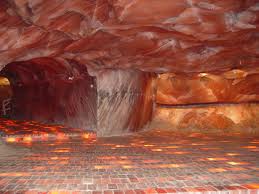 Crystal Salt refers to a specific crystal salt coming from a particular region
in Northeast Pakistan and has been the subject of comprehensive
medical research. Khewra Salt Mine is many thousands of years old and is the second largest salt mine in the world.
This Salt contains 84 minerals and trace elements that are necessary for health, and
is a holistic, and natural salt that is much more than just sodium, and chloride such as refined table salt.
Crystal Salt refers to a specific crystal salt coming from a particular region
in Northeast Pakistan and has been the subject of comprehensive
medical research. Khewra Salt Mine is many thousands of years old and is the second largest salt mine in the world.
This Salt contains 84 minerals and trace elements that are necessary for health, and
is a holistic, and natural salt that is much more than just sodium, and chloride such as refined table salt.
These minerals have been subjected to enormous pressure, and have crystallized over
millions of years. The higher the amount of pressure the more superior or
excellent the state of order within the crystalline structure. Salt,
for us, is foremost an information carrier and not a spice. For
information to be absorbed into our cells, a crystalline structure is
necessary. Chemically, a stone and a quartz crystal are both silicates.
However, the vast difference in the amounts of pressure they were
subjected to, distinguishes them. The quartz crystal embodies a perfect
geometric form, a perfect state of order within its structure. The
stone does not. Its elements are coarse, because it was not subjected
to enough pressure to create a crystalline structure. Crystal salt
layers wind through the mountain of salt, shimmering in transparent
white, pinkish or reddish veins. Only with sufficient pressure were the minerals transformed into crystal salt. The
elements trapped within are particles small enough to be able to pass through cell walls and be metabolized.
Healing Qualities of Salt
For thousands of years salt has been known as a panacea. Alchemists called
it the fifth element besides water, earth, air and, fire because its
qualities were comparable only to ether, the actual fifth element. Why
are we so drawn to the ocean? Because our subconscious mind
instinctively wants to return to the specific vibrational state of the
ocean from which we once emerged. This is where we can return to
recharge our batteries and regenerate. It was only two-hundred-fifty
 years ago, with the advent of industrialization, that we initiated our
disconnection from nature and her ways. Fortunately, we are witnessing
a trend to return back to natural, holistic methods for living and
caring for our body, including a shift back to utilizing natural salts
in this process. People everywhere are reconsidering the healing
effects of natural crystal salt. We can find it in skin care lotions
and for use as bath salts, and it is even used in inhalation or
cleansing treatments for illnesses of the respiratory system and for a variety of other indications
years ago, with the advent of industrialization, that we initiated our
disconnection from nature and her ways. Fortunately, we are witnessing
a trend to return back to natural, holistic methods for living and
caring for our body, including a shift back to utilizing natural salts
in this process. People everywhere are reconsidering the healing
effects of natural crystal salt. We can find it in skin care lotions
and for use as bath salts, and it is even used in inhalation or
cleansing treatments for illnesses of the respiratory system and for a variety of other indications
Hospital carved out of the expansive salt mountain
The healing properties of salt are also known in allopathic medicine. The
largest and oldest salt works in Europe occupies the royal salt mine of
Wieliczka, Poland, just 7.5 miles outside of Krakow. Here, a hospital
was carved out of the expansive salt mountain, seven hundred forty feet
below the surface, specifically for asthmatics and patients with lung
disease and allergies. Several thousand patients have been successfully
treated in this hospital. The healing rate is astonishingly over 90%.
Recognition of the healing effects of salt chambers has influenced the
construction of a similar underground spa located in the salt mine of
Berchtesgaden in Germany. The therapeutic benefits of long-term
residency inside the healing salt chambers are allopathically acknowledged.
Dr. Batmanghelidj MD recommends salt
Dr. Batmanghelidj MD - "Use 1/4 tsp. of sea salt for every
quart of water you drink. Use a good sea salt, one with
at least 80 minerals, liberally with food. As long as you drink the water, you
can use the salt. Some put it in their water, some lick it off their hand, some
season their foods after cooking. It's up to you. Make sure you take potassium
daily (banana, orange juice,etc)
Salt water when drunk has an expectorant effect in the stomach and increases
gastric juice secretion. It raises the level of stomach acid, hastens its production,
impedes or stimulates stomach motricity and emptying-rate (depending upon the
salt concentration), increases the secretion of the pancreas, and at higher
salt concentrations stimulates the formation of bile acids.
The Mayo Clinic had pronounced Lloyd Palmer, of Minnesota, as incurable.
Since 1965 he had suffered from excruciatingly painful arthritis of his spinal
column -- ankylosing spondylitis. His spine twisted and lost movement until,
he says, he became a "walking comma." He suffered pain for 31 years, until he
started to drink water and take salt. He writes: "I continue to
be pain-free with my ankylosis spondylitis one year after starting the water/salt
regime. My blood pressure is normal as well. I thank God every day for allowing
me to finally be pain-free." Lloyd Palmer's story is so incredible that Paul
Harvey reported it on his ABC News program. He also wrote a syndicated column,
printed in a few hundred newspapers.
Hydrotherapy with salt
Water therapy has been used for centuries to heal the
sick
Hydro- and hydrothermal therapy are traditional methods of treatment
that have been used for the treatment of disease and injury by many cultures,
including those of ancient Rome, China, and Japan. Water therapy has been around
for centuries. The ancient Greeks took clay and mineral therapeutic baths. Water is an important
ingredient in the traditional Chinese and Native American healing systems.

Study Reveals Profound Life-Giving Properties of Salt
 Results
of a comprehensive, scientific research project studying the effects of water
and salt on a myriad of body functions reveal some impressive indicators about
the affect that drinking Fiji Water and taking Crystal Salt can have on the body.
Results
of a comprehensive, scientific research project studying the effects of water
and salt on a myriad of body functions reveal some impressive indicators about
the affect that drinking Fiji Water and taking Crystal Salt can have on the body.
A nine-week double-blind university study undertaken in 2003 at the Inter-University
of Graz, Austria, examined the effects of drinking a minimum of 1.5 liters of
quality water per day with common table salt vs. a minimum of 1.5 liters of FIJI
Water with Crystal Salt on physical and psychological functions of the body.
In the study, patients who drank Fiji Water together with the
Crystal Salt saw significant positive changes in respiratory, circulatory,
organ, connective tissue and nervous system functions. Patients also reported
increases in the quality of sleep, energy and concentration levels, brain activity,
weight loss, enhanced consciousness and noticeable nail and hair growth.
Biophysical Examination by Segmentary Diagnosis (Imedis)
The biophysical examinations were performed by the expert system, IMEDIS.
This system captures the primary state of homeostasis as well as the
immediate reaction of the body to altered environmental influences. In
diagnosing the body's reactions to one or several environmental
influences, the patients were subjected to a so-called 'neutral'
environment. The result of these referential measurements serves as a
comparative basis for measurements of bodily functions within altered
situations. These measurements were performed according to the
experiences of biofunctional organometry as well as to the methods of
segmentary diagnosis. The focus of this test was to pinpoint the
energetic and informational effects on the homeostasis (biofunctional regulatory behavior).
The results of the organometric measurements confirm, with no ambiguity,
its supportive effects through a continuous decrease in deviating
factors. The diagnosis of the organs and the reactions in the
vegetative nervous system illuminates the energetic and informational
relationship between the water and the crystalline sole and its effects
on the homeostatic regulatory behavior. This diagnosis helps determine
the major pathological and pre-pathological tendencies as well as
functional disorders and physiological tensions. The tests confirmed
that all of the previously determined organ dysfunctions regained their
original, natural state of balance and proved the regulating and
balancing power of the crystalline sole.
Salt Crystal Lamps
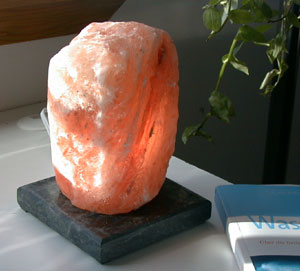 According to research, the heated salt crystal lamps can be referred to as natural
ion generators. When the sun heats up our largest natural salt solutions, the
oceans, it generates the natural energy vibration that our entire global environment
consists of. The Translucent salt crystal creates exactly the same natural energy
field. Scientifically speaking, this natural ionization process takes place
millions of times, invisible to the eye, and without any influence of the quality
of the crystal. Similar to the concept whereby tree leaves absorb dangerous
dioxides and transform them into essential oxygen, without damaging the plant.
According to research, the heated salt crystal lamps can be referred to as natural
ion generators. When the sun heats up our largest natural salt solutions, the
oceans, it generates the natural energy vibration that our entire global environment
consists of. The Translucent salt crystal creates exactly the same natural energy
field. Scientifically speaking, this natural ionization process takes place
millions of times, invisible to the eye, and without any influence of the quality
of the crystal. Similar to the concept whereby tree leaves absorb dangerous
dioxides and transform them into essential oxygen, without damaging the plant.
Crystal salt is one of the few minerals whose atomic structure is bound electrically,
not molecularly. This characteristic of the mineral structure enables the crystal
to change back and forth from crystalline to liquid state. This natural ionization
creates an electric charge, a pure natural energy vibration.
The crystal salt lamp can help neutralize the positive ions and electromagnetic
field frequencies. Therefore, our human energy field will be balanced through
the harmonizing energy vibration of the crystal. This can help with relaxation,
strengthen the immune system, the heart, the adrenals, the thyroid, to mention
just a few of our major physical body functions.

The Essential Health Benefits of Sea Water
Sea water has a history of therapeutic use. Its application to the body, warmed
and usually combined with massage, is referred to as Thalassotherapy, originating
from the Greek word thalassa. Both the Greeks and the Romans recognised the
therapeutic effects of sea water. The immediate general effects of warm sea
water application (it can penetrate the skin more easily when warm, and enter
into the blood) is relaxing, regenerative and stimulating. The American Indians
who resided in the Utah area near the Great Salt Lake regularly drank small
quantities of the inland sea water. They discovered that this practice enhanced
the effect of their herbal remedies. It was based on this folk use that Hartly
Anderson set up a company to extract the exceptionally pure and concentrated
form of sea water and to market it for health purposes.
Speleotherapy - Salt Therapy for respiratory illnesses
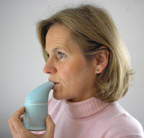 Several
research reports the benefit of Halo/Speleo therapy that can improve a condition
of people suffering in chronic and allergic diseases of respiratory system such
as asthma, allergy, rhinitis, bronchitis and chronic obstructive pulmonary disease.
Skulimowski (1965) reports an improvement of salt therapy with the group of
100 COPD and asthma patients after applying the treatment of speleotherapy 4
hours a day for 6-8 weeks. Hovarths (1986) conducts a medical reserch and shows
successful results in salt therapy in a group of more than 4000 patients in
a 10-year period in a hospital-cave complex in Tapolca, Hungary. He shows that
a sharp and long-lasting clinical improvement and a significant recovery from
airway obstruction could be observed in the overwhelming majority of patients.
Several
research reports the benefit of Halo/Speleo therapy that can improve a condition
of people suffering in chronic and allergic diseases of respiratory system such
as asthma, allergy, rhinitis, bronchitis and chronic obstructive pulmonary disease.
Skulimowski (1965) reports an improvement of salt therapy with the group of
100 COPD and asthma patients after applying the treatment of speleotherapy 4
hours a day for 6-8 weeks. Hovarths (1986) conducts a medical reserch and shows
successful results in salt therapy in a group of more than 4000 patients in
a 10-year period in a hospital-cave complex in Tapolca, Hungary. He shows that
a sharp and long-lasting clinical improvement and a significant recovery from
airway obstruction could be observed in the overwhelming majority of patients.
Life giving Ancient Minerals
An abundance of the minerals in unrefined
real salt are as synonymous with life today as they were a billion years ago
before single cells appeared here. Lack of them is synonymous with birth defects,
organ failure, decay, diseases, premature aging and death at a young age.
The problem with salt is not the salt itself but the condition of the salt
we eat - refined! Major producing companies dry their salt in huge kilns with
temperatures reaching 1200 degrees F, changing he salt's chemical structure,
which in turn adversely affects the human body. The facts are that in the heating
process of salt, the element sodium chloride goes off into the air as a gas.
What remains is sodium
 hydroxate which is irritating to the system and does
not satisfy the body's hunger and need for sodium chloride.
hydroxate which is irritating to the system and does
not satisfy the body's hunger and need for sodium chloride.
Sodium chloride is one of the 12 daily essential minerals. In countries which
do not alter their salt supply, heart disease and arthritis are so rare that
many doctors have never seen a case. Their salt is dried from the ocean by the
sun. Many people believe that salt is harmful to the human body. The truth is
we cannot live without salt (sodium chloride). From salt the body makes hydrochloric
acid which is one of the essential digestive fluids. There is not enough natural
salt in our foods, so we must supplement our diet. When salt is withheld, weakness
and sickness follow.
Try this experiment: Mix a spoonful of salt in a glass
of water and let it stand overnight. If the salt collects on the bottom of the
glass, it has been processed. NATURAL SALT DISSOLVES! Salt that will not dissolve
in water cannot dissolve in your body. Any foreign substance that collects in
the body organs and tissues will eventually result in malfunctioning of essential
body processes: heart disease, arthritis, hardening of the body tissues and
arteries, calcium deposits in the joints, etc. Natural organic salt (saline)
will not cause calcification in your body. Natural, unprocessed salt can dissolve
damaging calcium deposits in the body.
Defining the precise roles of salt
Science and medicine have tried to define the precise roles of salt in the
healthy and diseased human organism. Blood, sweat, and tears all contain salt,
and both the skin and the eyes are protected from infectious germs by the anti-bacterial
effect of salt. When salt is added to a liquid, particles with opposite charges
are formed: a positively charged sodium ion and a negatively charged chloride
ion. This is the basis of osmosis which regulates fluid pressure within living
cells and protects the body against excessive water loss (as in diarrhoea or
on heavy sweating).
Sodium and chloride ions, as well as potassium ions, create
a measurable difference in potential across cell membranes. This ensures that
the fluid inside living cells remains separate from that outside. Thus, although
the human body consists mainly of water, our "inner ocean" does not flow away
or evaporate. Sodium ions create a high pressure of liquid in the kidneys and
thus regulate their metabolic function. Water is extracted through the renal
drainage system. The body thus loses a minimal amount of essential water. Out
of 1500 liters of blood which pass daily through the kidneys, only about 1.5
liters of liquid leave the body as urine.
Fuel for the nerves
Salt is "fuel" for nerves. Streams of positively and negatively charged ions
send impulses to nerve fibers. A muscle cell will only contract if an impulse
reaches it. Nerve impulses are partly propelled by co-ordinated changes in charged particles.
Look what happens to fish
"Fish from the ocean will die quickly if placed in a solution of refined
salt and water. The sodium chloride, in its form as it comes from the refinery,
is actually poisonous to them. Bottom line, is that yes it can be harmful to
consume too much refined salt, but you cannot consume too much
natural unrefined salt."

Beware of "Sea salt" Labels
On the labels of many packaged food, in supermarkets as well as health food
stores the name "sea salt" appears often. Reading this, we feel safe and reassured,
thinking that when it comes to the salt part of the ingredients. This supermarket
or health food store "sea salt" has been totally refined. At its origin, it
may have come from the sea, but it has been harvested mechanically from dirt or concrete basins with bulldozers
and piped through metal conduits; put through many degrading artificial processes;
heated under extreme heat levels in order to crack its molecular structure;
robbed of all of its essential minerals that are essential to our physiology;
these elements are extracted and sold separately to industry. Precious and highly
prized by the salt refiners, these bring more profits than the salt itself.
Further adulterated by chemical additives to make it free- flowing, bleached,
and iodized. To call what remains "sea salt" would be quite misleading. In addition,
harmful chemicals have been added to the processed, altered unnatural substance
to mask and cover up all of the impurities it has. These added chemicals include
free flowing agents, inorganic iodine, plus dextrose and bleaching agents. Standard
salt additives: Potassium-Iodide (added to the salt to avoid Iodine deficiency
disease of thyroid gland), Sugar (added to stabilize Iodine and as anti-caking
chemical), Aluminum silicate.
Real unrefined unheated untreated natural sea-salt
Long before the earth knew pollutants of any kind, a huge, ancient sea covered
what is now North America. Pure, natural salt was the main ingredient of this
sea, and over millions of years, the water in the sea evaporated, leaving the
salt in undisturbed deposits. At some point during the earth's Jurassic era,
a range of volcanoes erupted around the ancient sea bed, sealing the salt with
thick volcanic ash, protecting these precious deposits against the pollution
that man would eventually introduce into the environment. Near the small town
of Redmond, in central Utah, approximately 200 miles south of Salt Lake City,
they carefully extract this salt from deep within the earth, and bring it to
you in its pure, natural state–without any additives, chemicals, or heat processing.
This is RealSalt, full of flavor and natural goodness–the way salt was meant
to be savored. The product of Utah is kosher certified and is endowed with more
than 50 natural minerals including iodine.
The right kind of salt is vital for your animals too!
 Herds of elephants risk injury and death in a perilous journey to hidden salt caves
where they supplement their sodium deficient diets. Our pets also suffer from
sodium deficiency. Farmers place salt-blocks on their pasture so that their
livestock and all other animals can lick the salt to their heart's content.
An abundance of the ingredients in unrefined real salt are as synonymous with
life today as they were a billion years ago before single cells appeared here.
Lack of them is synonymous with birth defects, organ failure, decay, diseases,
premature aging and death at a young age. Long before the earth knew pollutants
of any kind, a huge, ancient sea covered what is now North America. Pure, natural
salt was the main ingredient of this sea, and over millions of years, the water
in the sea evaporated, leaving the salt in undisturbed deposits.
Herds of elephants risk injury and death in a perilous journey to hidden salt caves
where they supplement their sodium deficient diets. Our pets also suffer from
sodium deficiency. Farmers place salt-blocks on their pasture so that their
livestock and all other animals can lick the salt to their heart's content.
An abundance of the ingredients in unrefined real salt are as synonymous with
life today as they were a billion years ago before single cells appeared here.
Lack of them is synonymous with birth defects, organ failure, decay, diseases,
premature aging and death at a young age. Long before the earth knew pollutants
of any kind, a huge, ancient sea covered what is now North America. Pure, natural
salt was the main ingredient of this sea, and over millions of years, the water
in the sea evaporated, leaving the salt in undisturbed deposits.
Be careful of Common table salt for your animals
 Please don't supplement your animal's diet with sodium chloride (common
table salt); all of the other beneficial elements have been removed. Animals
need unrefined, unprocessed real salt. Major producing
companies dry their salt in huge kilns with temperatures reaching 1200 degrees
F, changing he salt's chemical structure, which in turn adversely affects the
human body. Avoid the common refined table salt. Domesticated animals need the right kind of salt
Please don't supplement your animal's diet with sodium chloride (common
table salt); all of the other beneficial elements have been removed. Animals
need unrefined, unprocessed real salt. Major producing
companies dry their salt in huge kilns with temperatures reaching 1200 degrees
F, changing he salt's chemical structure, which in turn adversely affects the
human body. Avoid the common refined table salt. Domesticated animals need the right kind of salt

 One way to provide salt to your pets is to provide two separate water bowls.
One bowl with real-unrefined-unheated-natural-sea-salt and one bowl without
salt, so that the animals can consume as much salt as they require. They will
drink from the bowl that contains salted water, however once they have had enough
salt, they will drink from the bowl that has plain water.
One way to provide salt to your pets is to provide two separate water bowls.
One bowl with real-unrefined-unheated-natural-sea-salt and one bowl without
salt, so that the animals can consume as much salt as they require. They will
drink from the bowl that contains salted water, however once they have had enough
salt, they will drink from the bowl that has plain water.
 Himalayan Salt Licks For Horses and other large Animals
Himalayan Salt Licks For Horses and other large Animals

Salt Facts
Salt has become an inexpensive and readily available commodity that is taken
for granted by most people. But in older times, wars were fought over salt,
and huge taxes were also levied on it. In some places, salt was in such high
demand that it was minted into coins that were as valuable as gold and functioned
as the basic currency for ancient civilizations.
Where salt was scarce it was traded ounce for ounce with gold–for as the
Roman statesman Cassiodorus observed, "Some seek not gold, but there lives not
a man who does not need salt."
Because everyone, rich and poor, craves salt, rulers going back at least
as far as the Chinese emperor Yu in 2200 B.C. have tried mightily to control
and tax it. Salt taxes helped finance empires throughout Europe and Asia, but
also inspired a lively black market, smuggling rings, riots, even revolutions.
Pure salt consists of the elements sodium and chlorine. Its chemical name
is sodium chloride and its formula is NaCl. Its mineral name is halite.
Table salt is a chemically simple combination of two components, sodium and
chlorine. The basic components of salt are, by themselves, potentially dangerous.
Sodium will ignite immediately if it comes into contact with water, and chlorine
is poisonous if ingested. In combination, though, the two elements form sodium
chloride, commonly known as salt. Salt is essential. Each of us contain from
four to eight ounces of salt. In the body, salt is as important to humans as
water or air. It helps maintain the normal volume of blood in the body and also
helps keep the correct balance of water in and around the cells and tissues.
Salt plays an important part in the digestion of food and is essential in making
the heart beat correctly. It is also necessary for the formation and proper
function of nerve fibers, which carry impulses to and from the brain. Sodium,
together with calcium, magnesium and potassium, helps regulate the body's metabolism.
The sodium in salt is an essential nutrient. In combination with potassium,
it regulates the acid-alkaline balance in our blood and is also necessary for
proper muscle functioning. When we don't get enough sodium chloride, we experience
muscle cramps, dizziness, exhaustion and, in extreme cases, convulsions and
death. Salt is essential to our well being.
For years, many researchers have claimed that salt threatens public health,
mostly by contributing to high blood pressure. Recently, though, other researchers
have begun to change salt's reputation. A recent review of salt studies conducted
over the past two decades concluded that there's no reason for doctors to recommend
reducing sodium intake for people with normal blood pressure. It may be that
most of us are protected from excessive salt by our kidneys, which regulate
the body's sodium level and eliminate any excess.
Salt cures aren't new. In the early 19th Century, sick people traveled to
rudimentary spas such as French Lick Springs in Indiana and Big Bone Lick, Kentucky,
to soak in salt springs. Today's more luxurious spas offer salt baths, glows,
rubs and polishes to exfoliate dead skin, stimulate circulation and relieve
stress.
All salts come from a sea, but are processed in different ways. The oceans
that once covered the earth left a generous supply of salt beds and underground
deposits.
There are two basic methods for removing salt from the ground: room-and-pillar
mining and solution mining. In room-and-pillar mining, shafts are sunk into
the ground, and miners break up the rock salt with drills. The miners remove
chunks of salt, creating huge rooms that are separated by pillars of salt. The
room-and-pillar method requires that about half the salt be left behind as pillars.
In solution mining, a well is drilled into the ground, and two pipes are lowered
into the hole. The pipes consist of a small central pipe inside a larger pipe.
The brine is either shipped as a liquid or evaporated in special devices called
vacuum pans to form solid salt.
Crystalline salt deposits are found on every continent. Oceans contained an
estimated four-and-a-half million cubic miles of it.
Only about five percent of the world's annual salt production ends up as
seasoning at the dinner table. The vast majority, however, pours into chemical
plants, where it leads the five major raw materials utilized by industry: salt,
sulfur, limestone, coal and petroleum.
Salt pickles cucumbers, helps pack meat, can vegetables, cure leather, make
glass, bread, butter, cheese, rubber and wood pulp. Salt has some 14,000 uses,
more than any other mineral.
Salt is essential. In humans, it is a basic component of taste, along with
sweet, sour and bitter.

The Conductivity of Salt
If you've ever taken chemistry in high school you're familiar with this simple experiment to
test the conductivity of salt. Two ends of an electrical wire are attached
to a light bulb. The other ends are submerged in a glass of water. Because
water alone is not conductive, the bulb does not light up.But when we
add a little salt to the water the bulb starts to glow. It's the
same with our body. When we lack the natural elements in salt we suffer
from a chronic energy deficit, or deficit of information. Salt cannot
be labeled as medication because that would imply that apples too were
a medicine. Salt is a core essential nutrient with exceptional abilities
and qualities fundamental for keeping us alive!
Salt Can Displace an Energy Deficit and Restore Balance
We can understand a perfect example of how a lack of energy can cause
suffering. At times we hear of major electrical shutdowns where several
states and millions of people are without electricity (energy). Everyone
living in the affected areas suffer from this lack of energy. In this
example it reflects the lack in our society. Something is missing in
our society that needs to be replaced. Only when we restore the energy,
restore the balance, we come back into harmony. We have to understand,
through suffering from lack of energy, exactly what we need to add to
our lives to relieve the suffering. Here, our society is also a body
suffering. If we choose, we can look for the cause and eliminate it,
just as we look for the cause of our own individual suffering.
Salt Reduction?
Roy Moxham: "In recent years there has been much publicity about the need to reduce salt
consumption in societies where salt is added to many processed
foods. It has tended to be forgotten
that some salt intake is absolutely necessary; that people
need salt, sodium chloride, to survive: The chemical requirements
of the human body demand that the salt concentration in
the blood be kept constant. If the body does not get enough
salt, a hormonal mechanism compensates by reducing the excretion
of salt in the urine and sweat. But it cannot reduce this
output to zero. On a completely salt-free diet the body
steadily loses small amounts of salt via the kidneys and
sweat glands. It then attempts to adjust this by accelerating
its secretion of water, so that the blood's salt concentration
can be maintained at the vital level. The result is a gradual
desiccation of the body and finally death."
 The past president of the American Heart Association, Dr. Suzanne
Oparil of the University of Alabama-Birmingham, said her
personal view is that the government may have been too quick
to recommend that everyone cut back. "Salt restriction as
a solitary recommendation for the population for the prevention
or the treatment of hypertension. An eight-year study of
a New York City hypertensive population stratified for sodium
intake levels found those on low-salt diets had more than
four times as many heart attacks as those on normal-sodium
diets the exact opposite of what the salt
hypothesis would have predicted."
The past president of the American Heart Association, Dr. Suzanne
Oparil of the University of Alabama-Birmingham, said her
personal view is that the government may have been too quick
to recommend that everyone cut back. "Salt restriction as
a solitary recommendation for the population for the prevention
or the treatment of hypertension. An eight-year study of
a New York City hypertensive population stratified for sodium
intake levels found those on low-salt diets had more than
four times as many heart attacks as those on normal-sodium
diets the exact opposite of what the salt
hypothesis would have predicted."
No Thoughts and No Actions Without Salt
Remember, energy and information are two terms used to describe the same thing. Even
the simplest processes in our body need salt, or its inherent elements
(ionized energy). Our nervous system is really a sophisticated energy
network. It transmits stimulation that is recorded via sensory input
(all of our senses are actually energy receptors, our eyes receive waves
of energy,information in the form of light frequencies, our ears
receive sound frequencies or patterns of energy and our nose senses
odors, also electrical charges in the atmosphere) Everything in the
universe works by the fundamental principals of energy! Anyway, these
sensory inputs that travel to our brain are passed on to our muscles
in order for them to react to the respective stimuli (electrical current).
An electric potential occurs on the membrane wall of a cell when the
positively charged potassium ions leave the cells and the positively
charged sodium ions cannot enter due to their size. The outside becomes
positively charged and the inside, negatively charged. When a nerve
cell is stimulated, its membrane suddenly becomes polar opposite and
is permeable for the sodium ions, allowing the electrical charge to
enter. Without the elements of potassium and sodium is salt, none of
this is possible. Not even a single thought, let alone an action, is
possible without their presence. First comes the thought, a wave of
energy received in the brain. This thought is nothing more than an electromagnetic
frequency. The salt is responsible for enabling this frequency to transmit
commands to the muscles and organs.